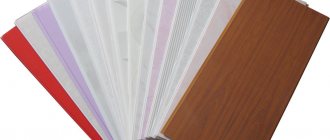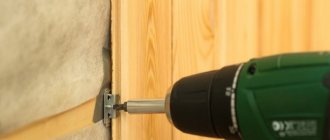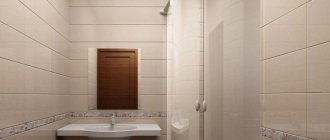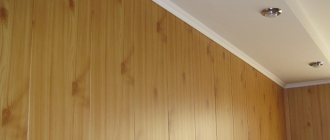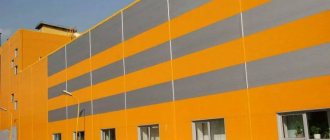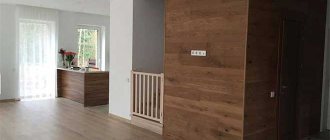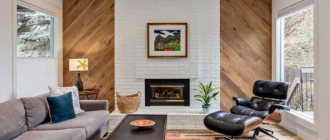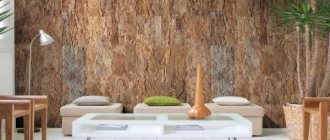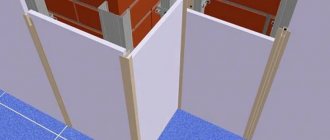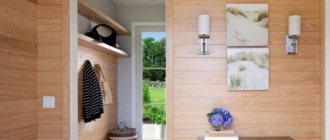What glue is best to use
One of the distinctive features of MDF panels is that they, like any other material containing wood, are resistant to moisture. In most cases, concrete surfaces are sheathed with such sheets. Both of these factors should, of course, be taken into account when choosing adhesive for MDF panels. The purchased fixing composition should not contain water in the first place. Also, the product must be designed to work with both wood and concrete.
Liquid nails are considered the most suitable options for fixing compounds for MDF. For finishing both wooden and concrete walls with MDF panels, a very good solution would be, for example, to use glue from the Titan wild group. “Moment Installation” and “Crystal” products are also excellent for fixing such sheets on any surface.
Corners and connections - we use a full range of fittings
The main advantage of working with MDF panels is that the fittings for cashing out the corner joints are mounted superficially, that is, after the installation of the sheathing is completed. It is highly not recommended to use plastic fittings with grooves for PVC panels. Trimming the panels must be done quite accurately, the gaps in the internal corners should not exceed 1.5–2 mm/linear. m, which is quite enough to compensate for temperature expansion.
The main element of the fittings is a universal corner profile. It consists of two thin MDF strips, bonded with laminated film, and can be used to decorate both internal and external corners. To ensure correct and beautiful alignment of the overlays at the corners, their edges are cut in a miter box at 45° with a general bevel outward. When finishing corners on slopes, the angle will not be correct, so local trimming is recommended. Installation is carried out using glue for wooden products based on polyvinyl concentrate.
Another element of the fittings is the joining strip. It is used for splicing sections of cladding when the length of the molding is insufficient or for combining panels of different colors in one plane. A mounting strip should be provided at the installation site of the connecting element.
What is Titan wild
This product belongs to the group of universal liquid nails and is professional. In essence, Titan wild glue is a chemical alternative to screws, nails and self-tapping screws. This composition can be used to fix MDF panels on surfaces made of absolutely any material. It is not allowed to use such a product only for polyethylene and polypropylene.
If necessary, gluing MDF panels using Titan wild is allowed both indoors and outdoors.
What are liquid nails used for?
Liquid nails are most often used for wood, fiberboard, chipboard, metal, brick, polystyrene and glass. You can also use them to glue heavy natural wallpapers, such as bamboo, and ceramic tiles.
Interesting materials:
How to check the authenticity of a Xiaomi product? How to check the distributor for a spark? How to check whether a transistor is working or not? How to check the tracking number? How to check the integrity of a transformer? How to check the Moscow digital pass? How to test cottage cheese with boiling water? How to test cottage cheese with iodine? How to test cottage cheese in water? How to check an outdoor thermometer?
Glue "Moment Montazh"
Liquid nails of this brand are also ideal for gluing MDF panels. Using “Moment” of this variety when decorating walls with such sheets, as in the case of Titan wild, is allowed both inside and outside. Consumers praise this glue for its optimal combination of price and quality.
This product is packaged in a special tube, which is inserted into a construction gun during operation. Using such a tool allows you to dispense “Moment Montazh” with high accuracy. And this, in turn, eliminates the possibility of overspending.
Among the advantages of this adhesive for MDF panels, consumers include, among other things, the fact that it does not have any unpleasant odor. In addition, you can work with this product at ambient temperatures from -20 to +70 °C.
“Moment Montazh” has received simply excellent reviews from consumers, including professionals. Many masters believe, among other things, that it has better qualities than even many imported compounds of the same group.
What to use to attach the folding corner to MDF panels?
They are very convenient to use, in addition, they are quite versatile and are suitable even for sharp or obtuse angles. This is what these corners look like:
Decorating walls with MDF panels involves mounting them on a wooden frame. For this purpose, slats 40mm wide and 20mm thick are used. This solution can be called optimal for two reasons:
- 1.
The panels themselves are quite light and a massive frame is absolutely not needed. - 2.
These are the parameters of wooden slats that are most common among both sellers and buyers, which means that finding them will not be difficult.
You will also need PVC plugs, nails, wood screws (from 4 to 8 cm), liquid nails for attaching corners and brackets for fixing panels.
Such brackets are called clamps or clamps; they usually come complete with the panels or separately; they can be bought in the same place where the panels themselves are sold. In the image below you can see what clamps are and how they perform their functions:
"Moment Crystal"
Liquid nails of this variety have also earned good reviews from consumers. Using Moment Crystal glue you can fix MDF panels on walls or, for example, on the ceiling as securely as possible. A distinctive feature of this product is, among other things, that it leaves absolutely no traces on the surfaces being joined.
Using “Moment Crystal” is very convenient, for example, in cases where no additional finishing is intended to be glued on top of MDF panels. In this way, in private houses, for example, attics, attics and various types of outbuildings are often finished.
One of the distinctive features of this variety of “Moment” is that the degree of its setting depends not on the duration, but on the pressing force of the panel. Among the advantages of this product, consumers include, among other things, moisture and frost resistance.
Main stages of gluing panels
Thus, we found out which adhesive is best to use for MDF panels. But how to install such sheets correctly? The installation procedure for MDF panels is carried out using liquid nails using the following technology:
- walls are being prepared;
- marking is carried out;
- panels are glued.
At the final stage, when covering the walls with MDF panels, the rosettes and corners are finished.
Frameless installation - covering walls with panels
There is an alternative installation method that involves the use of “liquid nails” glue. The panels can be glued either to the frame or directly to the walls, if the unevenness on them does not exceed 2 mm/m. Often this is the method chosen for cladding unfinished brick or block masonry; it is only important to choose the correct adhesive composition.
It is recommended to use quality products. The glue must remain flexible after drying; give preference to compounds based on rubber or polyurethane. For occasionally heated dachas, you should choose frost-resistant glue; other features are determined by the surface material for gluing.
Don't forget to properly prepare the walls. Masonry and plaster must be thoroughly impregnated with primer mixtures to increase adhesion.
How to prepare
At this stage, work should be done as carefully as possible and in compliance with all required technologies. If the walls are not prepared correctly for gluing the sheets, the MDF panels will not last long on them.
Before installing the sheets, the old finish should first be removed from the surfaces. Also, the walls must be cleaned of dust, dirt and fungus. Next, when preparing to glue the panels:
- cracks in the walls are repaired;
- they are carefully aligned;
- the surface is primed.
Marking
Thus, it is clear what glue to use to glue MDF panels. But before you begin this procedure, you should definitely make markings on the walls. In order for MDF sheets to stand up straight and subsequently hold firmly for many years, before installing them, vertical lines should be applied to the surface to be finished. You can mark the walls when gluing such panels, for example, using a plumb line or level. But it is best to use a level for this purpose. With the use of such a device, lines on the walls can be drawn as accurately as possible.
Installation technology
After the markings have been applied, they begin the main stage of work using glue for MDF panels. Liquid nails of all the varieties discussed above are quite expensive. However, their consumption when installing MDF panels is usually not too large. This material is installed on walls or ceilings using the following technology:
- strips of glue are applied around the perimeter of the sheet without interruption;
- the same strips are applied with glue along the diagonals of the panel;
- Additionally, glue is applied to the entire panel area in thick drops in increments of no more than 20 cm.
The panel coated in this way is then pressed tightly against the wall, after which it is abruptly torn away from it. This is necessary so that the stripes and points of liquid nails are slightly weathered. Next, the panel is pressed against the wall again, this time for good. After the first sheet is fixed, according to the markings they begin to install the second. Small MDF panels on the surfaces to be finished should be placed staggered in rows.
When using reliable glue for MDF panels and at the same time following all the required technologies, it will be possible to fix the sheets on the walls and ceilings as reliably as possible. When attaching such material, it is important to press it against the surface to be finished as firmly as possible. This will guarantee reliable fixation of the panels and durability of the cladding.
Paneling walls is popular for several reasons - there is no need to level the walls, remove wallpaper, paint or other covering. Finishing is convenient and simple. The method is cost-effective and clean thanks to the consumables, the main one of which is glue for MDF panels. There are quite a few varieties of it, so it’s worth getting to know the main ones before starting repairs.
How to glue a plastic corner onto wallpaper
There are two ways to fix plastic corners on walls covered with wallpaper:
- on wallpaper without trimming;
- onto the wall surface with trimming a strip of wallpaper.
If the wallpaper is smooth or has a shallow relief pattern, then you can glue the plastic corners to the wallpaper without trimming. If the relief of the pattern is large, then unaesthetic gaps form between the strip and the surface of the wallpaper, in which dust accumulates. In this case, it is better to glue the corners while trimming the wallpaper. To do this, the profile is applied to the installation site and a strip of wallpaper is cut along its edges on both sides with a paint knife.
How to cut correctly
For simple cutting of PVC corners, use scissors, a hacksaw or a grinder with a metal disc. If it is necessary to precisely align the corner joints at the required angle (usually 90° or 45°). For accurate cutting in this case, use a miter box or a self-made template, which allows you to get an even edge of the profile.
How to glue
After choosing the method of gluing the corners (on wallpaper or with trimming them), the step-by-step instructions look like this:
- Glue is applied to the inner sides of the corner.
- The plastic profile is applied to the corner of the walls and pressed using a dry sponge or napkin.
- The profile is fixed to the surface with masking tape.
- When the glue has firmly set, the tape is removed.
The glue must be applied closer to the center of the corner in waves, strokes or dots. This will reduce the likelihood of excess glue squeezing out beyond the edge of the corner and will prevent the wallpaper near it from getting dirty. If excess glue does get on the wallpaper, you need to wait until it dries completely, then use a sharp knife or blade to remove the excess, being careful not to damage the finish.
Since the PVC profile is flexible, it is difficult to level it by hand. To do this, use a metal ruler or rule paired with a building level.
As for fixing the corners with tape, you can glue plastic corners onto the slopes without it. But gluing plastic corners for arches onto wallpaper is more difficult and you can’t do without securing the decorative corners with tape. The type of tape is selected based on the type of finish, so both masking and packaging tape can be used.
When joining the corners, their ends are also coated with glue, the excess of which is removed from the plastic after the glue has completely dried.
When forming arches whose length exceeds the length of the PVC corner, extensions are made from pieces of corners. In this case, it is better to make the center of the arch from a solid profile, and add extensions to the sides. The joints of the profiles can be sealed with silicone sealant to match the color of the plastic.
Requirements for the adhesive composition
Despite the wide variety of MDF adhesives on the market, they all meet a number of requirements:
- the purpose of the composition has specific purposes - for working with chipboards or for universal use;
- the coupling with any base is strong and reliable;
- resistance to humidity, chemicals, temperature changes - increased;
- strong or super strong adhesion.
There are no frost resistance requirements for MDF glue, since the panels are most often intended for indoor use.
What glue is suitable
Despite the wide variety of adhesives for MDF, their main purpose is to tightly and reliably glue and adhere the panels to the wall. All its types are divided into groups:
- universal compounds;
- special;
- polyurethane foam;
- liquid Nails.
Compounds for MDF stickers
Compounds, or polymer resin, contain “Moment”, “Titanium” and other additives, thanks to which the adhesive is used on wooden, stone, and metal surfaces.
A distinctive feature of this glue is its versatility.
Special Edition
Chemists have developed this series for gluing not only to ordinary surfaces, but also to concrete. It can be used by both professional builders and amateurs who decide to do the repairs themselves. As a supplement to the glue, a gun is used, which makes gluing MDF much easier.
The special series includes “Montage”, “Macroflex” and others. Their fixation is strong and reliable. It is possible to economically apply a thin layer of glue and use it to eliminate surface defects.
Construction foam
Despite the fact that construction foam is most often used for sealing, its use when installing panels is quite possible. Construction foam is produced in two types - for external and internal use. When fixing MDF panels, it is permissible to use both types of fasteners. After drying, the polyurethane foam remains soft. Flexibility avoids deformation of MDF. This is especially true if their composition is based on wood chip materials.
Liquid Nails
The glue is universal, has high adhesion, resistance to corrosion, and can be used for installation of various building materials, especially those containing wood. Due to its ease of use, the option of using liquid nails is very popular. Using a gun, applying glue is convenient.
Features of using glue for MDF panels
The most durable fastening is achieved on smooth, dry, grease-free surfaces. The universal or mounting compound is applied pointwise in large drops or in zigzag movements, after which you need to wait a while (the duration of the technological break is indicated on the label), attach the panel to the wall, press and tap over the entire surface with a fist or a rubber mallet.
Correct application of glue on MDF panel
For adjustment, the master has from 5 to 15 minutes, after which the composition polymerizes and hardens. Excess glue should be removed immediately with a damp cloth or alcohol, and after hardening it can be cut off with a sharp knife.
Panels can also be glued to the wall using construction foam. The technology gets a little more complicated. The base needs to be moistened with a spray bottle, a thin layer of mounting compound applied, the panel attached, pressed, then torn off and reattached. Tap the surface thoroughly and leave until completely hardened.
We warn you! Any construction adhesive is a toxic chemical multicomponent compound. It has a toxic odor and negatively affects health, so when working, ensure an intense flow of fresh air, constant ventilation, and even better, exhaust ventilation. As soon as signs of poisoning appear (dizziness, nausea, suffocation, etc.), you need to stop work, leave the room and take sorbents before the doctor arrives.
If the adhesive comes into contact with the skin, it may cause irritation, so the affected area should be washed with plenty of water and a mild detergent and treated with symptomatic treatments.
Review of effective brands
Among the above groups of glue, several brands with high performance have gained the most popularity. According to reviews from professionals, when choosing, you should give preference to such brands.
Titan wild
Glue belongs to the group of liquid nails and is a universal professional product. The Titan wild composition successfully replaces fastening with screws, self-tapping screws or nails. The glue is capable of fixing MDF panels on any surface. It is used both indoors and outdoors. The advantages of the brand include:
- reliable fixation without damaging the structure of the material;
- moisture resistance - 100%;
- cost-effectiveness;
- setting speed;
- Possibility of use at different temperatures.
Titebond
The adhesive is based on an aliphatic resin. It is used in carpentry for gluing wooden parts, applying laminate, MDF, chipboard, and assembling furniture. The advantages of Titebond glue include:
- fast setting;
- readiness to work;
- resistant to moisture, heat, solvents;
- ensuring the strength of the bonding boundary is much higher than that of wood.
The glue has the appearance of a viscous yellow emulsion, after drying it is translucent. Resistant to freezing, ignites when temperatures exceed 100 ⁰С.
"Moment-1"
Universal adhesive “Moment-1” is perfect for gluing surfaces made of different materials, is moisture-resistant and can withstand temperatures from -40 ⁰С to +110 ⁰С. The glue dries very quickly thanks to the components included in it:
- rubber resins;
- rosin;
- ethyl acetate;
- acetone;
- hydrocarbons.
Glue "Moment-1" is a light yellow thick liquid. The optimal temperature for work is from +18 ⁰С to +25 ⁰С. When attaching the panels, air flow should be ensured to avoid poisoning by toxins.
Tytan Euro-Line 601
Adhesive is a type of universal construction adhesive. It is used indoors and outdoors. The base on which MDF is mounted can be made of wood, concrete, brick, or plaster.
Tytan Euro-Line 601 adhesive is based on rubber. It is used for repairs and finishing with MDF panels. The main characteristics include:
- strong and fast grip;
- strength;
- hardening within 24 hours;
- heat resistance ranging from -30 to +60
"Moment Crystal"
The glue is colorless, transparent, dries quickly and leaves no marks as a result of working with it. Liquid nails reliably fix MDF panels installed on the ceiling or walls indoors. "Moment Crystal" is well suited for gluing panels without top finishing.
The peculiarity of this variety is that the speed and reliability of setting depends on the force with which the surfaces were pressed. “Moment Crystal” is characterized by high frost and moisture resistance.
Makroflex MF220 Heavy duty
This brand of glue is intended for joining different materials:
The form of the glue is a white paste based on polyacrylates. The optimal temperature for fixation is +10 ⁰С and above. Among the characteristics of Makroflex:
- maximum holding time - 15 minutes;
- no odor;
- Possibility of use outdoors and indoors;
- great gripping force.
Liquid Nails LN-910 Panels
This brand of liquid nails is indispensable for quickly covering a room with panels, gluing decorative elements, baseboards, and moldings. The adhesion is reliable if brick, concrete, wood, plywood, chipboard and other materials are used as the base.
The adhesive is intended for interior use. It is distinguished by a number of characteristics:
- elasticity;
- the ability to adjust the gluing within 15 minutes after connection;
- obstacle to deformation;
- long (up to 20 years) service life;
- ability to freeze and defrost.
Liquid Nails LN-901 Heavy Duty
The composition is based on synthetic rubber. Capable of creating the strongest connections in difficult conditions. Can be used both indoors and outdoors. Sets quickly. Can be used at temperatures from -40 ⁰С to +70 ⁰С. The following materials are used as glued materials:
Temperatures from -40 °C to +70 °C are optimal for operation, from +5 °C to +38 °C - for work.
Types of adhesives for mounting MDF boards
So, what types of adhesives provide the best fastening of panels to the wall? Conventionally, they can be divided into three groups:
- All-purpose compounds designed to work with heavy-duty products made of stone, alloy, glass, rubber, wood, polystyrene, etc. This category includes such well-known compounds as Titan (Titan Wild), Titebond (Multi Purpose), Moment (Moment-1), Tytan (Euro-Line No. 601) and others.
- Special assembly adhesives from the “Water Nails” series. In frameless construction they are in great demand among both experts and amateurs.
One of the favorites on the Russian market is Moment Watery Nails glue.
In addition, an iron system called a “gun” is purchased, which facilitates the use of glue. Let's name some popular compositions:
- Moment (Moment-montage or Moment Crystal),
- Titebond (Heavy Duty extra strong and Solvent Free extra strong without solvent),
- Makroflex (MF220 Heavy Duty),
- Liquid Nails “Water Nails” (LN-910 Panels and LN-901 Heavy Duty) and others.
- Polyurethane foam. Naturally, the main purpose of this product is sealing, but craftsmen often use this compound to glue panels to the wall and even the ceiling. Every manufacturer has at least two types of this composition in its assortment: for interior work and all-purpose. For our purposes, any one will do.
Choosing foam is now no less simple than choosing glue
For less experienced craftsmen, the composition “Water Nails” is better suited for installing MDF panels on the wall. The glue is quite easy to use, the fastening comes out strong and can be peeled off; it is applied in a thin or thick layer, so you can smooth out small surface imperfections.
After drying, the installation composition remains flexible and elastic, thereby ensuring resistance to deformation and vibration. This is especially important for boards made of particle board materials, because they are characterized by changes in linear dimensions with changes in temperature and environmental humidity.
Operating Instructions
Knowing some secrets of technology, it is not difficult to fasten MDF parts. There are two main ways:
- using lathing;
- gluing the panels to the prepared base.
Each method has its positive sides:
- when using the first method, the condition of the walls does not matter;
- a metal frame in rooms with high humidity will keep the panels undamaged longer;
- insulation fits well under the sheathing;
- the second method is less expensive and easier.
Pasting on the wall
Before gluing the panels, the wall is prepared and proceed according to plan:
- Old wallpaper, dirt is removed, the surface is degreased.
- The wall is primed.
- Mark the panels and cut out the required size.
- Apply the adhesive in waves or dots to panels or walls.
- Gently, but with force, press down on the MDF to glue them together.
- If necessary, align the joints.
- The seams are filled with sealant.
- Leave the panels to dry.
Common Mistakes
Inexperienced craftsmen often try to choose colorless MDF glue for panels, fearing that it may stand out in the area of joints and give an untidy appearance to the finish. This is not entirely true, since joining the panels “in a groove” eliminates this possibility. All the glue remains on the back side.
If the composition accidentally gets on the front side, you should not wipe it with a cloth that is too damp, as the decorative coating may peel off.
When using polyurethane foam, you need to pay attention to its shrinkage coefficient and choose a brand with a low rate. The foam can collapse and not stick if you do not wait for a while after its application.
